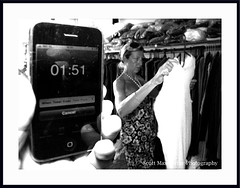What is the
opportunity cost of a sale, and why should sales professionals know, or care?
So to help anybody who hasn’t come across the theory before, or the many who will have heard the words, but not really understood their meaning, we’ll explain the theory, and give examples of how it works in real world situations.
A good starting point is our article –
Learning Business Lessons From The Golf Caddie. This explains how caddies know a great deal more about business theory than anybody would think. The particular relevance is every business has limited resources. The golf caddie only has two shoulders, two legs, and 24 hours in each day. The only chance of growing revenues is making better use of them.
And now for the theory. (We can blame economists for this, although here is one case where they all agree.) The opportunity cost of doing something with your scarce resource is the maximum value you could have achieved by using that resource in another way.
A simple example. Joe gets lucky, inheriting $50,000 from a distant aunt’s estate. He decides to buy himself a treat. His aunt would want him to do that, wouldn’t she? He buys a new sports car, the cost of which is $50,000. But was that the right decision? The opportunity cost of spending the money on the car is the original amount plus all the interest he would have made over the rest of his life, had he decided to put the money in a savings account. That interest gets compounded of course. The opportunity cost of buying the car works out at $169,319 after 25 years at an average interest rate of 5%.
Applying this theory to selling, we can see the sales rep who spends her time chasing one particular deal, with one particular customer, attracts an opportunity cost amounting to the value of the other deal she could have won had she chased that instead. Assuming her deal comes in, making her a commission of $1,000, her opportunity cost might be zero if there are no other deals to chase, or might be $10,000 if she could have spent that time winning her dream client. Given the best scenario, she gives up $10,000 in order to make $1,000. An opportunity cost of $9,000 its simple for any sales guy to understand. Assuming the deal she decides to work on fails, and she makes nothing, that opportunity cost is $10,000.
This is why
Reengineering Sales Management is paranoid about chasing deals which aren’t going to come in. Qualification, and strategy, and process are the tools which help new order sales people figure out the good deals from the bad, and make sure the good ones come home.
An exciting, and somewhat counterintuitive, philosophy. Enough to get any diehard activity focused, hard closing, 800lb sales gorilla thinking.
But wait. That’s only part of the story.
The other side is about the customer’s opportunity cost.
Every prospect has the same constraints on resources – money, and people, and time, and energy. The sales guy wanting to close this prospect needs to understand, whatever the prospect says, there is always some alternative decision. Always an opportunity cost. Every prospect can decide to buy from the competition, or decide to buy something else, or decide not to do anything at all.
The ultimate competition in every deal is not Fast Closing Fred with the flexible price book and questionable customer service. It’s the opportunity cost.
And here’s the red meat slide. Sales people wanting to close prospects need to persuade them that opportunity cost is negative. An alternative decision will actually cost them money, or value in some way.
That’s hard to do, unless the rep really understands the customer, and can offer credible evidence of unique value together with built in
risk management.
Try doing that, by telling rather than selling. Pitching an exciting story and closing hard won’t work, with prospects who are already faced with the dilemma of how to get the biggest bang for their buck.
What does work? Really understanding the customer’s aspirations, proving an ability to deliver, offering a program to manage risk, and a unique capability to add value.
Why doesn’t the traditional approach to selling and sales management work so well any more? What can the modern sales professional do to stay relevant in today’s customer driven markets? Check out our eBook Reengineering Sales Management for ideas on how to embrace the new order of customer driven buyer/seller relationships.

